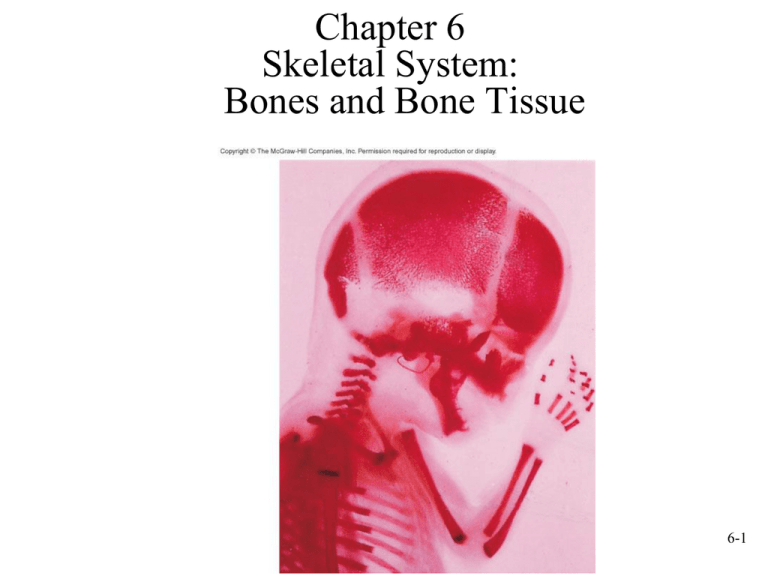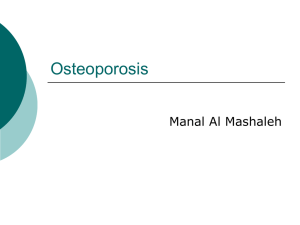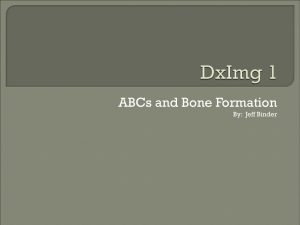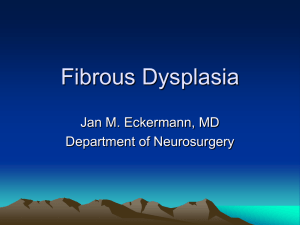
Chapter 6
Skeletal System:
Bones and Bone Tissue
6-1
Functions of the Skeletal System
• Support. Bone is hard and rigid; cartilage is
flexible yet strong. Cartilage in nose, external ear,
thoracic cage and trachea. Ligaments- bone to
bone
• Protection. Skull around brain; ribs, sternum,
vertebrae protect organs of thoracic cavity
• Movement. Produced by muscles on bones, via
tendons. Ligaments allow some movement
between bones but prevent excessive movement
(joint: formed where two or more bones come together------allows movement between bones)
• Storage. Ca and P. Stored then released as
needed. Fat stored in marrow cavities
• Blood cell production. Bone marrow that gives
rise to blood cells and platelets
6-2
Components of Skeletal System
• Bone
• Cartilage: three types
– Hyaline
– Fibrocartilage
– Elastic
• Tendons and ligaments (Tendons: muscle to bone
Ligament: bone to bone)
6-3
Hyaline Cartilage
• Consists of specialized cells that produce matrix
– Chondroblasts: form matrix
– Chondrocytes: surrounded by matrix; are lacunae
• Matrix. Collagen fibers for strength, proteoglycans for resiliency
• Perichondrium. Double-layered C.T. sheath. Covers cartilage except at
articulations
– Inner. More delicate, has fewer fibers, contains chondroblasts
– Outer. Blood vessels and nerves penetrate. No blood vessels in
cartilage itself
• Articular cartilage. Covers bones at joints; has no perichondrium
• Growth
– Appositional. New chondrocytes and new matrix at the periphery
(chondroblasts in perichondrium lay down new matrix & new chondrocytes)
– Interstitial. Chondrocytes within the tissue divide and add more
matrix between the cells.
6-4
Bone Histology
• Bone matrix. Like reinforced concrete. Steel bars
is collagen fibers, cement is hydroxyapatite
– Organic: collagen and proteoglycans (35%)
– Inorganic: hydroxyapatite. CaPO4 crystals (65%)
• If mineral removed, bone is too bendable
• If collagen removed, bone is too brittle
6-5
Bone Histology
• Bone cells
–
–
–
–
Osteoblasts
Osteocytes
Osteoclasts
Stem cells or osteochondral progenitor cells
• Woven bone: collagen fibers randomly oriented
• Lamellar bone: mature bone in sheets
• Cancellous bone (spongy): contain trabeculae
-less bone matrix & more space
• Compact bone: dense
-more bone matrix & less space
6-6
Bone Cells
• Osteoblasts
– Formation of bone through
ossification or osteogenesis.
Collagen produced by E.R. and
golgi. Released by exocytosis.
Precursors of hydroxyapetite stored
in vesicles, then released by
exocytosis.
– Ossification: formation of bone by
osteoblasts. It occurs by appositional
growth on surface of previously existing
bone. Osteoblasts communicate
through gap junctions. Bone matrix
produced by osteoblasts covers the
older bone & surrounds osteoblasts
results in new layer of bone.
6-7
Bone Cells
• Osteocytes. Mature bone cells
once surrounded by matrix. They
are relatively inactive, but can
make small amounts of matrix to
maintain it.
– Lacunae: spaces occupied by
osteocyte cell body
– Canaliculi: canals occupied by
osteocyte cell processes
– Nutrients diffuse through tiny
amount of liquid surrounding cell
and filling lacunae and canaliculi.
Then can transfer nutrients from one
cell to the next through gap
junctions.
6-8
Bone Cells
• Osteoclasts. Responsible for resorption of bone
(breakdown of bone)
– Ruffled border (projections): where cell membrane
borders bone and resorption is taking place.
– H ions pumped across membrane, acid forms, eats
away bone.
– Release enzymes that digest the bone.
– Derived from monocytes (which are formed from stem
cells in red bone marrow)
– Multinucleated
• Stem Cells. Mesenchyme (Osteochondral
Progenitor Cells) become chondroblasts or
osteoblasts. (Remember: osteocytes derived from osteoblasts)
6-9
Woven and Lamellar Bone
• Woven bone. Collagen fibers randomly oriented.
- first formed during fetal development or repair of fracture
- after formation, osteoclasts break down woven bone & osteoblasts
build new matrix---------------this process called remodeling
• Remodeling
– Removing old bone and adding new
– Woven bone is remodeled into lamellar bone
• Lamellar bone
– Mature bone in sheets called lamellae. Fibers are
oriented in one direction in each layer, but in different
directions in different layers for strength.
6-10
Cancellous (Spongy) Bone
• Trabeculae: interconnecting rods or plates of bone. Like
scaffolding.
–
–
–
–
Spaces filled with marrow & blood vessels.
Covered with endosteum.
Oriented along stress lines
Trabeculae consist of several lamellae (thin sheets) w/ osteocytes
located in lacunae between them
6-11
Compact Bone
•
Central or Haversian canals: parallel
to long axis
•
Lamellae: thin sheets/layers
concentric (circles), circumferential
(perimeter, periphery), interstitial (between
osteon)
•
Osteon or Haversian system: central
canal (also called haversian canals------contains
blood vessels that run parallel to long axis of
bone), associated concentric lamellae
and osteocytes
•
Perforating or Volkmann’s canal:
perpendicular to long axis. Both
perforating and central canals contain
blood vessels. Central canals receive
blood vessels from perforating canals &
nutrients in blood enter central canals,
pass into canaliculi, move through
osteocytes to osteocytes (by gap junctions)6-12
.
Waste removed in reverse direction.
Bone Shapes
• Long
– Ex. Upper and lower
limbs
• Short
– Ex. Carpals and tarsals
• Flat
– Ex. Ribs, sternum,
skull, scapulae
• Irregular
– Ex. Vertebrae, facial
6-13
Structure of a Long Bone
• Diaphysis
– Shaft
– Compact bone
• Epiphysis
– End of the bone
– Cancellous bone
• Epiphyseal plate: growth plate (separates
epiphysis from diaphysis)
– Hyaline cartilage; present until
growth stops
• Epiphyseal line: bone stops growing in
length (epiphyseal plate becomes epiphyseal line)
• Medullary cavity (space): In children
medullary cavity is red marrow,
gradually changes to yellow in limb
bones and skull (except for epiphyses of
long bones). Rest of skeleton is red.
6-14
Structure of a Long Bone, cont.
• Periosteum
– Outer is fibrous (contains blood vessels & nerves)
– Inner is single layer of bone cells
including osteoblasts, osteoclasts and
osteochondral progenitor cells
– Tendons & ligaments attach to bone &
become continuous with fibers of
periosteum.
– Sharpey’s fibers: some collagen fibers
of tendons or ligaments penetrate the
periosteum and into the bone.
Strengthen attachment of tendon or
ligaments to bone.
• Endosteum. Similar to periosteum,
but more cellular. Lines all internal
surfaces of all cavities including
spaces in cancellous bone.
6-15
Structure of Flat, Short,
and Irregular Bones
• Flat Bones
– No diaphyses, epiphyses
– Sandwich of cancellous
between compact bone
• Short and Irregular Bone
– Compact bone that surrounds
cancellous bone center; similar
to structure of epiphyses of
long bones (bec. have processes
that possess epiphyseal growth plates
– No diaphyses and not
elongated
• Some flat and irregular
bones of skull have sinuses
(air filled spaces) lined by mucous
membranes.
6-16
Bone Development
(during fetal development)
• Intramembranous ossification
– Takes place in connective tissue membrane
• Endochondral ossification
– Takes place in cartilage
• Both methods of ossification
– Produce woven bone that is then remodeled
– After remodeling, formation cannot be
distinguished as one or other
6-17
Intramembranous Ossification
(8th week – 2 years of development)
•
•
•
•
Takes place in connective tissue membrane
formed from embryonic mesenchyme
Forms many skull bones, part of mandible,
diaphyses of clavicles
When remodeled, indistinguishable from
endochondral bone.
Centers of ossification: locations in membrane
where ossification begins (centers of ossification expand
outwards to form a bone by gradually ossifying the membrane)
•
Fontanels: large membrane-covered spaces
between developing skull bones; unossified (bones
eventually grow together & all fontanels have closed by 2 years of age)
6-18
Intramembranous Ossification
6-19
Endochondral Ossification
• Bones of the base of the skull, part of the
mandible, epiphyses of the clavicles, and
most of remaining bones of skeletal system
• Cartilage formation begins at end of fourth
week of development
• Some ossification beginning at about week
eight; some does not begin until 18-20 years
of age
6-20
Endochondral Ossification
6-21
Endochondral Ossification
6-22
Endochondral Ossification
6-23
Endochondral Ossification
6-24
Growth in Bone Length
• Growth in length occurs at the epiphyseal plate
• Involves the formation of new cartilage by
– Interstitial cartilage growth
– Appositional growth on the surface of the cartilage
• Closure of epiphyseal plate: epiphyseal plate is
ossified becoming the epiphyseal line. Between 12
and 25 years of age
• Articular cartilage: does not ossify, and persists
through life
• Appositional growth only
– Interstitial growth cannot occur because matrix is solid
– Occurs on old bone and/or on cartilage surface
ex: trabeculae grow in size by the deposition of new bone matrix by
osteoblasts onto the surface of the trabeculae.
6-25
Zones of the Epiphyseal Plate
6-26
Growth in Bone Length
6-27
Growth at Articular Cartilage
• Increases size of bones with no epiphyses: e.g.,
short bones
• Chondrocytes near the surface of the articular
cartilage similar to those in zone of resting cartilage
• The process of growth in articular cartilage is
similar to that occurring in the epiphyseal plate,
except that the chondrocyte columns are not as
obvious.
• When epiphyses reach their full size, the growth of
cartilage & its replacement by bone cease.
• However, articular cartilage persists throughout life
& does not become ossified as does epiphyseal
6-28
plate.
Fracture of the Epiphyseal Plate
6-29
Growth in Bone Width
6-30
Factors Affecting Bone Growth
• Size and shape of a bone determined genetically but can be
modified and influenced by nutrition and hormones
• Nutrition
– Lack of calcium, protein and other nutrients during growth and
development can cause bones to be small
– Vitamin D
• Necessary for absorption of calcium from intestines
• Can be eaten or manufactured in the body
• Rickets: lack of vitamin D during childhood (bowed bones)
• Osteomalacia: lack of vitamin D during adulthood leading to
softening of bones
– Vitamin C
• Necessary for collagen synthesis by osteoblasts
• Scurvy: deficiency of vitamin C (causes ulceration & hemorrhage in
body)
• Lack of vitamin C also causes wounds not to heal (because requires
collagen synthesis), teeth to fall out (because ligaments that hold them in
place break down)
6-31
Factors Affecting Bone Growth
(cont.)
• Hormones
– Growth hormone from anterior pituitary. Stimulates
interstitial cartilage growth and appositional bone
growth
– Thyroid hormone required for growth of all tissues
– Sex hormones such as estrogen and testosterone
• Cause growth at puberty, but also cause closure of the
epiphyseal plates and the cessation of growth
6-32
Bone Remodeling
• Converts woven bone into lamellar bone
• Caused by migration of Basic
Multicellular Units (BMU)
– Groups of osteoclasts and osteoblasts that
remodel bones
• Involved in bone growth, changes in bone
shape, adjustments in bone due to stress,
bone repair, and Ca ion regulation
• Relative thickness of bone changes as
bone grows. Bone constantly removed by
osteoclasts and new bone formed by
osteoblasts.
• Formation of new osteons in compact
bone
– Osteoclasts enter the osteon from blood in
the central canal and internally remove
lamellae. Osteoblasts replace bone
– Osteoclasts remove bone from the
6-33
exterior and the bone is rebuilt
Bone Repair
1.
Hematoma formation. Localized mass of blood released from blood vessels
(damaged from fracture) but confined within an organ or space. Clot formation
(consists of fibrous proteins that stop the bleeding).
2.
Callus formation. Callus: mass of tissue that forms at a fracture site and
connects the broken ends of the bone.
- Internal- blood vessels grow into clot in hematoma (several days after fracture).
• Macrophages clean up debris, osteoclasts break down dead tissue,
fibroblasts produce collagen and granulation tissue.
• Chondroblasts from osteochondral progenitor cells of periosteum and
endosteum produce cartilage within the collagen.
• Osteoblasts invade. New bone is
formed.
- External- collar around opposing
ends. Periosteal osteochondral
progenitor cells osteoblasts
and chondroblasts. Bone/cartilage
collar stabilizes two pieces.
6-34
Bone Repair, cont.
3.
4.
Callus ossification. Callus replaced by woven,
cancellous bone through endochondral ossification.
Bone remodeling. Replacement of cancellous bone and
damaged material by compact bone. Sculpting of site by
osteoclasts
6-35
Calcium Homeostasis
• Bone is major storage site for calcium
• The level of calcium in the blood depends
upon movement of calcium into or out of
bone.
– Calcium enters bone when osteoblasts create
new bone; calcium leaves bone when
osteoclasts break down bone
– Two hormones control blood calcium levelsparathyroid hormone (produced by parathyroid gland---blood calcium decreases then secretion of PTH increases which
increases # of osteoclasts) and calcitonin ( produced by
thyroid gland----decreases osteoclast activity
6-36
Calcium Homeostasis
6-37
Effects of Aging on Skeletal
System
• Bone matrix decreases. More brittle due to lack of collagen;
but also less hydroxyapatite.
• Bone mass decreases. Highest around 30. Men denser due to
testosterone and greater weight. African Americans and
Hispanics have higher bone masses than Caucasians and
Asians. Rate of bone loss increases 10 fold after menopause.
Cancellous bone lost first, then compact.
• Increased bone fractures
• Bone loss causes deformity, loss of height, pain, stiffness
– Stooped posture
– Loss of teeth
6-38
Bone Fractures
• Open (compound)- bone break with
open wound. Bone may be sticking
out of wound.
• Closed (simple)- Skin not perforated.
• Incomplete- doesn’t extend across the
bone. Complete- does
• Greenstick: incomplete fracture that
occurs on the convex side of the curve
of a bone
• Hairline: incomplete where two
sections of bone do not separate.
Common in skull fractures
• Comminuted fractures: complete with
break into more than two pieces
6-39
Bone Fractures, cont.
• Impacted fractures: one
fragment is driven into the
cancellous portion of the
other fragment.
• Classified on basis of
direction of fracture
• Linear
• Transverse
• Spiral
• Oblique
• Dentate: rough, toothed,
broken ends
• Stellate radiating out from a
central point.
6-40








